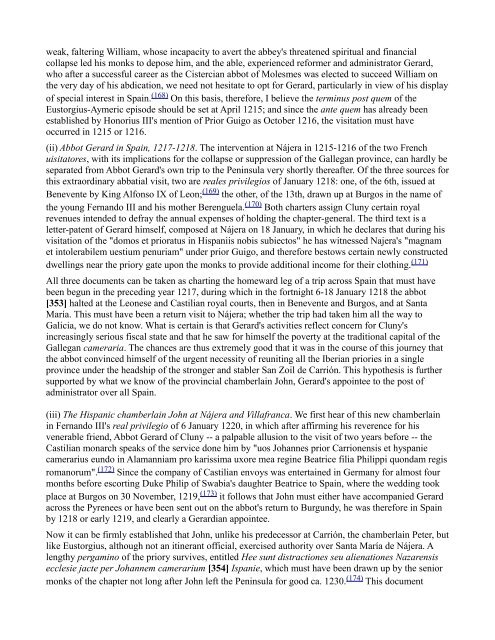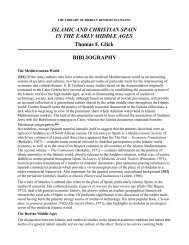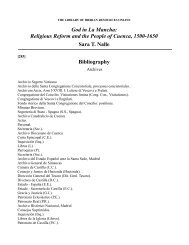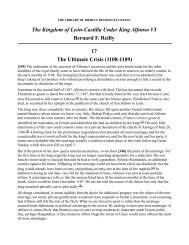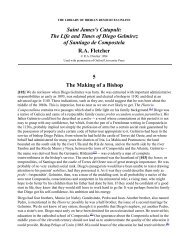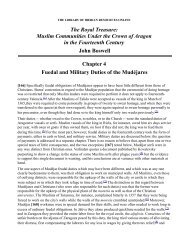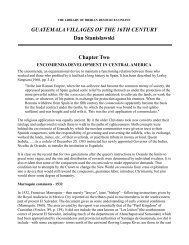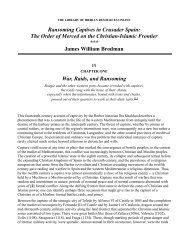The Cluniac Priories of Galicia and Portugal - The Library of Iberian ...
The Cluniac Priories of Galicia and Portugal - The Library of Iberian ...
The Cluniac Priories of Galicia and Portugal - The Library of Iberian ...
You also want an ePaper? Increase the reach of your titles
YUMPU automatically turns print PDFs into web optimized ePapers that Google loves.
weak, faltering William, whose incapacity to avert the abbey's threatened spiritual <strong>and</strong> financial<br />
collapse led his monks to depose him, <strong>and</strong> the able, experienced reformer <strong>and</strong> administrator Gerard,<br />
who after a successful career as the Cistercian abbot <strong>of</strong> Molesmes was elected to succeed William on<br />
the very day <strong>of</strong> his abdication, we need not hesitate to opt for Gerard, particularly in view <strong>of</strong> his display<br />
<strong>of</strong> special interest in Spain. (168) On this basis, therefore, I believe the terminus post quem <strong>of</strong> the<br />
Eustorgius-Aymeric episode should be set at April 1215; <strong>and</strong> since the ante quem has already been<br />
established by Honorius III's mention <strong>of</strong> Prior Guigo as October 1216, the visitation must have<br />
occurred in 1215 or 1216.<br />
(ii) Abbot Gerard in Spain, 1217-1218. <strong>The</strong> intervention at Nájera in 1215-1216 <strong>of</strong> the two French<br />
uisitatores, with its implications for the collapse or suppression <strong>of</strong> the Gallegan province, can hardly be<br />
separated from Abbot Gerard's own trip to the Peninsula very shortly thereafter. Of the three sources for<br />
this extraordinary abbatial visit, two are reales privilegios <strong>of</strong> January 1218: one, <strong>of</strong> the 6th, issued at<br />
Benevente by King Alfonso IX <strong>of</strong> Leon; (169) the other, <strong>of</strong> the 13th, drawn up at Burgos in the name <strong>of</strong><br />
the young Fern<strong>and</strong>o III <strong>and</strong> his mother Berenguela. (170) Both charters assign Cluny certain royal<br />
revenues intended to defray the annual expenses <strong>of</strong> holding the chapter-general. <strong>The</strong> third text is a<br />
letter-patent <strong>of</strong> Gerard himself, composed at Nájera on 18 January, in which he declares that during his<br />
visitation <strong>of</strong> the "domos et prioratus in Hispaniis nobis subiectos" he has witnessed Najera's "magnam<br />
et intolerabilem uestium penuriam" under prior Guigo, <strong>and</strong> therefore bestows certain newly constructed<br />
dwellings near the priory gate upon the monks to provide additional income for their clothing. (171)<br />
All three documents can be taken as charting the homeward leg <strong>of</strong> a trip across Spain that must have<br />
been begun in the preceding year 1217, during which in the fortnight 6-18 January 1218 the abbot<br />
[353] halted at the Leonese <strong>and</strong> Castilian royal courts, then in Benevente <strong>and</strong> Burgos, <strong>and</strong> at Santa<br />
María. This must have been a return visit to Nájera; whether the trip had taken him all the way to<br />
<strong>Galicia</strong>, we do not know. What is certain is that Gerard's activities reflect concern for Cluny's<br />
increasingly serious fiscal state <strong>and</strong> that he saw for himself the poverty at the traditional capital <strong>of</strong> the<br />
Gallegan cameraria. <strong>The</strong> chances are thus extremely good that it was in the course <strong>of</strong> this journey that<br />
the abbot convinced himself <strong>of</strong> the urgent necessity <strong>of</strong> reuniting all the <strong>Iberian</strong> priories in a single<br />
province under the headship <strong>of</strong> the stronger <strong>and</strong> stabler San Zoil de Carrión. This hypothesis is further<br />
supported by what we know <strong>of</strong> the provincial chamberlain John, Gerard's appointee to the post <strong>of</strong><br />
administrator over all Spain.<br />
(iii) <strong>The</strong> Hispanic chamberlain John at Nájera <strong>and</strong> Villafranca. We first hear <strong>of</strong> this new chamberlain<br />
in Fern<strong>and</strong>o III's real privilegio <strong>of</strong> 6 January 1220, in which after affirming his reverence for his<br />
venerable friend, Abbot Gerard <strong>of</strong> Cluny -- a palpable allusion to the visit <strong>of</strong> two years before -- the<br />
Castilian monarch speaks <strong>of</strong> the service done him by "uos Johannes prior Carrionensis et hyspanie<br />
camerarius eundo in Alamanniam pro karissima uxore mea regine Beatrice filia Philippi quondam regis<br />
romanorum". (172) Since the company <strong>of</strong> Castilian envoys was entertained in Germany for almost four<br />
months before escorting Duke Philip <strong>of</strong> Swabia's daughter Beatrice to Spain, where the wedding took<br />
place at Burgos on 30 November, 1219, (173) it follows that John must either have accompanied Gerard<br />
across the Pyrenees or have been sent out on the abbot's return to Burgundy, he was therefore in Spain<br />
by 1218 or early 1219, <strong>and</strong> clearly a Gerardian appointee.<br />
Now it can be firmly established that John, unlike his predecessor at Carrión, the chamberlain Peter, but<br />
like Eustorgius, although not an itinerant <strong>of</strong>ficial, exercised authority over Santa María de Nájera. A<br />
lengthy pergamino <strong>of</strong> the priory survives, entitled Hee sunt distractiones seu alienationes Nazarensis<br />
ecclesie jacte per Johannem camerarium [354] Ispanie, which must have been drawn up by the senior<br />
monks <strong>of</strong> the chapter not long after John left the Peninsula for good ca. 1230. (174) This document


